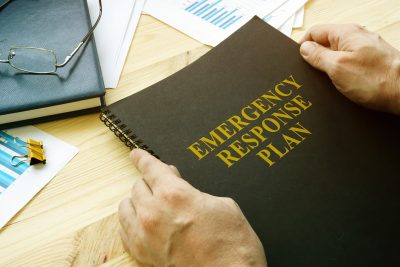If an emergency happens, do you have a plan for yourself or loved ones with disabilities?
Being prepared means planning ahead. To be ready for an emergency means you are informed, have an emergency plan, and you have a survival kit.
Be informed
Do you know what natural disasters can happen in your area? How does your local community inform public of emergency? Do you know your community’s evacuation plan or emergency shelters? One of the ways the Red Cross encourages people to be informed is to sign up for local alerts to your phone or email. The Emergency Alert System (EAS) state plan includes a list of radio stations by area you can tune into for emergency alerts. FEMA has their own mobile app that alerts users to emergencies, gives the locations of recovery centers, and provides emergency kit checklists. The Red Cross’ Be Informed page also lists important information to keep you safe when a disaster happens.
Make a plan
Part of making a plan is creating escape routes accessible for everyone within your household and finding a meeting spot. If you’re making a plan that includes someone that uses a wheelchair, the escape route must be wheelchair accessible.
Your plan should include what steps to take before, during and after a disaster. Confirm that everyone is on the same page. The Red Cross includes a 3 step process to create your emergency plan, as well as some templates to write your plans down.
The 3 steps are:
- With your family or household members, discuss how to prepare and respond to the types of emergencies that are most likely to happen where you live, learn, work and play.
- Identify responsibilities for each member of your household and how you will work together as a team.
- Practice as many elements of your plan as possible.
Build a kit
Some of the things you may consider when building a disaster kit are;
having adequate food and water supply, a first aid kit, extra clothing, sanitation, flashlight, batteries, medications, sleeping bags, and copies of important documents are a few of the necessary items to include in your kit.
Build a Kit is a baseline place to start when thinking about what you would add to your emergency kit. There are additional items FEMA suggests adding to your kit. For families that have specific dietary restrictions or allergies, Amazon and Legacy Foods have products that are gluten-free and other specially made for other dietary needs. Other options for pre-assembled emergency preparation supplies include Emergency Kits.com, Stealth Angel, and The Red Cross.
Emergency Preparedness for People with Disabilities
The Red Cross has a page dedicated to disaster safety for people with disabilities. This page walks you through the process of preparing for an emergency as a person with special needs. From things like creating your own personal assessment, to registering with your local emergency assistance program.
Emergency Preparedness Tool Kit for People with Disabilities is a comprehensive downloadable booklet complete with checklists and resources to help you prepare.
Disaster Readiness Resources for People with Disabilities and Their Families from the Family Network on Disabilities has information in English and Spanish.
Centers for Disease Control and Prevention
Caring for Children in a Disaster
“Planning is key. It is important for families to have an emergency care plan in place in case a public health emergency like a natural disaster, act of terrorism, or disease outbreak occurs.”
Ready.gov
“How might a disaster affect you? Could you make it on your own for at least three days? After a disaster, you may not have access to a medical facility or even a drugstore, so it’s crucial to plan for the resources you use regularly, and what you would do if those resources are limited or not available.”
Disaster preparedness for children with special needs
Back-up Caregivers and Personal Emergency Response System
Children and Youth with Special Healthcare Needs in Emergencies
Early Childhood Disaster – Related Resources for Children and Families
Emergency Planning in a Pandemic
Pediatric Disaster Preparedness Toolkit
Psychological First Aid Online Course
Ready.gov for Kids
Sesame Street for Parents: Emergency Preparation Toolkit

